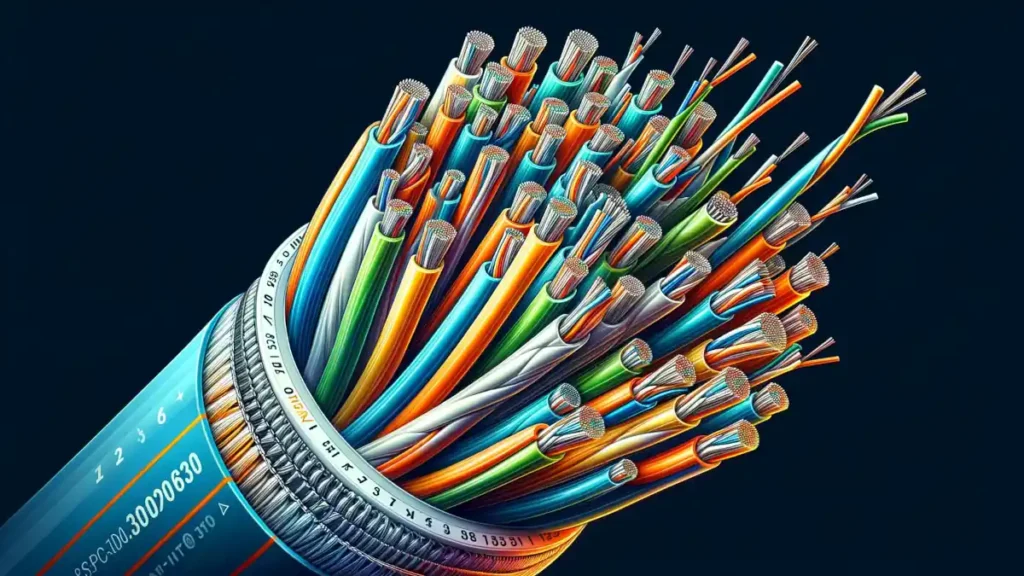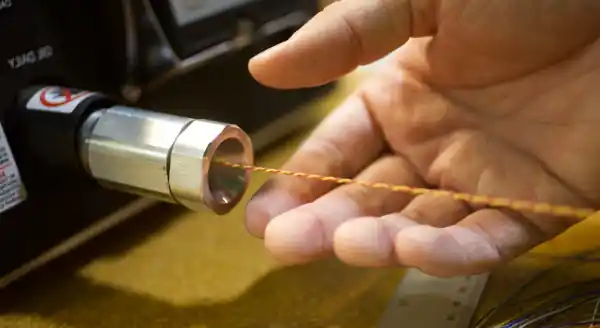A twisted pair cable is a type of wiring in which two conductors are intertwined to cancel out electromagnetic interference from external sources and improve signal integrity. Central to modern network infrastructures, these cables are pivotal in transmitting data for both telecommunications and computer networking.
This article will provide an in-depth exploration of twisted pair cables, covering their history, types, and various categories as defined by industry standards. Expect a comprehensive journey through the evolution, application, and technological nuances of twisted pair cables.
Table of Contents:
- What is a Twisted Pair Cable?
- Historical Context
- Types of Twisted Pair Cables
- ANSI/EIA Categories of Twisted Pair Cable
- Twisted Pair Cable in Modern Networking
- Installation and Best Practices
- References

1. What is Twisted-Pair cabling?
A twisted pair cable consists of pairs of insulated copper wires twisted together. Each pair comprises two conductors, typically copper wires, encased in color-coded insulation. The twisting of the wires serves a vital purpose: it reduces electromagnetic interference (EMI) and crosstalk between adjacent pairs and external sources.
Fundamental Principles
- Electromagnetic Interference Reduction: The twist in the wires cancels out EMI from external sources. When an external electromagnetic field hits the pair, one wire becomes positively charged, and the other negatively, effectively nullifying the interference.
- Minimizing Crosstalk: Crosstalk, interference from adjacent pairs within the same cable, is also mitigated by the twisting. Each twist occurs at different intervals for each pair, reducing the chance of signal interference between them.
- Signal Integrity: Twisted pair cables maintain a high level of signal integrity over distances, making them suitable for telecommunications and data transmission.
2. Historical Context
Invention and Early Applications
Twisted pair cabling was first used in the late 19th century. Its invention is attributed to Alexander Graham Bell, the pioneer of the telephone. Initially, twisted pair cables were employed in telephone lines, where they significantly improved communication quality by reducing external noise and interference.
Evolution in Telecommunications and Networking
- Telecommunications Breakthrough: In the early 20th century, as telephone networks expanded, twisted pair cables became the backbone of telecommunication infrastructures. Their ability to minimize interference was crucial in densely wired areas and long-distance communications.
- Adoption in Computer Networking: With the advent of computer networking, twisted pair cables found a new realm of application. They became the standard medium for short-haul networks, offering a balance between cost, ease of installation, and performance.
- From Analogue to Digital: The transition from analog to digital communications in the latter half of the 20th century further cemented the role of twisted pair cables. Their ability to handle higher bandwidths made them ideal for the burgeoning internet and local area networks (LANs).

In summary, twisted pair cables have played a pivotal role in the evolution of both telecommunication and computer networking. From their humble beginnings in telephone lines to becoming the standard in network wiring, their journey is a testament to their effectiveness and versatility in an ever-advancing technological landscape.
3. Types of Twisted Pair Cables
Unshielded Twisted Pair Cables (UTP)
- Characteristics: UTP cables, the most common type of twisted pair cabling, consist of wires that are twisted together without additional shielding. The lack of shielding makes them thinner and more flexible.
- Applications: Widely used in home and office networks for Ethernet connections, telephone lines, and LAN networks.
- Pros:
- Cost-Effective: UTP cables are generally less expensive and easier to install than shielded variants.
- Flexibility: Due to their thinner and more flexible design, they are easier to handle and install in confined spaces.
- Cons:
- Susceptibility to Interference: UTP cables are more prone to electromagnetic interference (EMI) and crosstalk compared to shielded cables.
- Limited Distance: Effective over shorter distances, making them less suitable for long-range applications.

Shielded Twisted Pair Cables (STP)
- Distinctive Features: STP cables include a conductive shield, typically made of copper or aluminum foil, which provides an additional layer of protection against EMI.
- Use Cases: Ideal for environments with high EMI, such as industrial settings or data centers. Also used in some high-speed network applications.
- Advantages:
- Improved Interference Resistance: The shielding in STP cables offers superior protection against EMI and crosstalk.
- Better Signal Quality: Enhanced signal integrity, especially in environments with potential interference.
- Disadvantages:
- Higher Cost: STP cables are more expensive than UTP due to additional materials and manufacturing processes.
- Less Flexibility: The shielding makes STP cables thicker and less flexible, posing challenges in tight installations.

4. ANSI/EIA Categories of Twisted Pair Cable
Twisted pair cables are categorized by the American National Standards Institute/Electronic Industries Alliance (ANSI/EIA) based on their performance characteristics. Each category represents a standard for network cabling.
- Category 3 (Cat3): Introduced in the early 1990s. Used for telephone wiring and 10BASE-T networks. Supports frequencies up to 16 MHz.
- Category 5 (Cat5): Commonly used in the late 1990s. Suitable for Fast Ethernet and early gigabit networks. Supports frequencies up to 100 MHz.
- Category 5e (Cat5e): An enhanced version of Cat5, introduced to support Gigabit Ethernet with improved crosstalk specifications. Supports frequencies up to 100 MHz.
- Category 6 (Cat6): Designed for gigabit networks and can support 10 Gigabit Ethernet over short distances. Offers improved performance with a frequency range of up to 250 MHz.
- Category 6a (Cat6a): An advancement of Cat6, supporting 10 Gigabit Ethernet over longer distances (up to 100 meters). Operates at frequencies up to 500 MHz.
- Category 7 (Cat7): Provides extensive shielding for reduced crosstalk and supports higher frequencies up to 600 MHz. Ideal for data centers and industrial applications.
- Category 7a (Cat7a): Cat7a represents a significant enhancement over its predecessor, Cat7. Engineered for optimal performance, it achieves a remarkable data transfer rate of 10 Gbps at a distance of 100 meters and escalates to 40 Gbps at 50 meters. Furthermore, it boasts an impressive maximum bandwidth capacity of 1 gigahertz (GHz). This advancement positions Cat7a as an ideal solution for 10 Gigabit Ethernet applications, offering a blend of speed and efficiency for high-bandwidth network environments.
- Category 8 (Cat8): Cat8 cable stands as a powerhouse in the realm of network cabling, tailored specifically for high-speed switch-to-switch communications. It shines in 25 Gbps and 40 Gbps network setups, delivering an exceptional maximum bandwidth of 2 GHz. The meticulous design of Cat8 incorporates foil wrapping for shielding, providing an almost total elimination of crosstalk, ensuring cleaner and more reliable data transmission. This robust shielding, however, imparts a degree of rigidity to the cable, making installation in confined spaces a challenging endeavor. Despite this, Cat8 has the potential to replace fiber optic cables in data centers for short-range connections, marking a significant milestone in cable technology and network infrastructure.
Each category of twisted pair cable has been developed to meet the evolving demands of network environments, from basic telephone communications to high-speed data processing and transmission. The choice of category depends on the specific requirements of the network, including speed, distance, and environmental factors.
5. Twisted Pair Cable in Modern Networking
In the dynamic landscape of modern networking, twisted pair cables continue to play a crucial role. Their evolution aligns with the advancing demands of network infrastructures.
Role in Contemporary Networks
- Adapting to Bandwidth Needs: Twisted pair cables have evolved to meet the increasing bandwidth requirements of modern applications. Categories like Cat6a and Cat7 support higher data rates, essential for applications like video conferencing and cloud computing.
- Supporting PoE: Power over Ethernet (PoE) capabilities in newer twisted pair cables facilitate the delivery of power along with data. This feature is instrumental in powering devices like security cameras and wireless access points directly through the network cable.
- Compatibility with Emerging Technologies: As IoT and smart building technologies proliferate, twisted pair cables provide the necessary infrastructure to connect and power a wide array of devices.
6. Installation and Best Practices
The installation and maintenance of twisted pair cables are pivotal in ensuring optimal network performance and longevity.
Installation Techniques
- Avoiding Physical Damage: During installation, avoid bending cables too tightly or stretching them, as this can damage the internal wiring.
- Proper Shielding and Grounding: For shielded twisted pair (STP) cables, ensure proper grounding and shielding to maximize protection against EMI.
- Cable Management: Use cable management systems to organize and protect the cables from physical damage and EMI.
Maintenance Practices
- Regular Inspections: Periodically inspect cable installations for any signs of damage or wear and tear.
- Environmental Considerations: Be mindful of environmental factors like temperature and humidity that can affect cable performance.
- Updating as Needed: Upgrade cabling infrastructure when expanding the network or implementing newer technologies that require higher bandwidths.
7. References
- “Data and Computer Communications” by William Stallings: Offers in-depth coverage of network and telecommunications technology, including detailed information on twisted pair cabling.
- “Cabling: The Complete Guide to Network Wiring” by David Barnett, David Groth, and Jim McBee: This comprehensive guide covers all aspects of network cabling, including twisted pair cables.
- ANSI/TIA-568 Standards: The Telecommunications Industry Association’s standards for telecommunications cabling, including specifications for twisted pair cabling.
- IEEE 802.3 Standards: Covering Ethernet and network technologies, these standards provide guidelines on the use of twisted pair cables in network infrastructures.